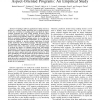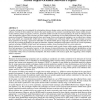208 search results - page 4 / 42 » Programmer-based fault prediction |
ISSRE
2010
IEEE
13 years 4 months ago
2010
IEEE
—Coupling in software applications is often used as an indicator of external quality attributes such as fault-proneness. In fact, the correlation of coupling metrics and faults i...
DATE
2007
IEEE
14 years 3 days ago
2007
IEEE
Future microprocessors will be highly susceptible to transient errors as the sizes of transistors decrease due to CMOS scaling. Prior techniques advocated full scale structural or...
TSE
2002
13 years 5 months ago
2002
A number of papers have investigated the relationships between design metrics and the detection of faults in object-oriented software. Several of these studies have shown that suc...
ISSTA
2012
ACM
11 years 8 months ago
2012
ACM
We introduce the concept of “residual investigation” for program analysis. A residual investigation is a dynamic check installed as a result of running a static analysis that ...
ISSTA
2004
ACM
13 years 11 months ago
2004
ACM
The ability to predict which files in a large software system are most likely to contain the largest numbers of faults in the next release can be a very valuable asset. To accomp...


